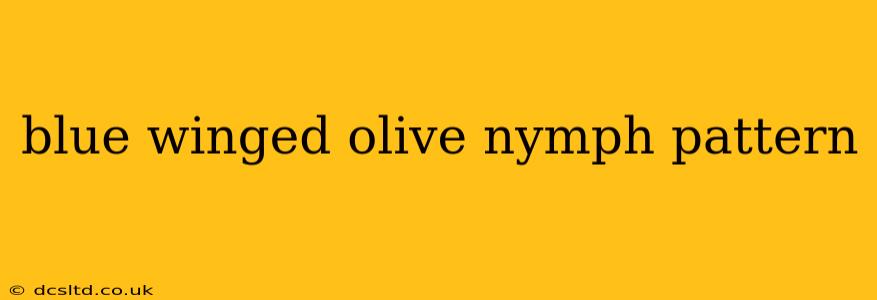The Blue Winged Olive (BWO) is a ubiquitous mayfly, crucial to the diet of many trout species. Its nymph stage is a particularly important food source, making mastering its imitation a vital skill for any serious fly fisher. This guide dives deep into the nuances of tying and fishing effective BWO nymph patterns, equipping you with the knowledge to consistently fool discerning trout.
What are the key characteristics of a Blue Winged Olive nymph?
The key to a successful BWO nymph pattern lies in accurately representing the insect's natural form. Real BWO nymphs are typically small, ranging from size 18 to 24. They exhibit a subtle, olive-brown body, often with a slightly paler underside. Their legs are short and sparse, and the thorax is slightly segmented. The most defining feature, however, is their delicate, translucent wings, which although not present in the nymph stage, are crucial to understanding the overall form and life cycle of the fly and, thus, its imitation. Their natural movements are subtle, often drifting slowly near the bottom or clinging to rocks and vegetation.
What are some popular Blue Winged Olive nymph patterns?
Several effective BWO nymph patterns exist, each with slight variations in material and tying techniques. Popular choices include:
-
Pheasant Tail Nymph: A classic and versatile pattern, the Pheasant Tail effectively mimics the BWO nymph's slender body and subtle coloration. Its simple construction makes it easy to tie, even for beginners.
-
Zebra Midge Nymph: Though not strictly a BWO pattern, the Zebra Midge's small size and dark coloration can be effective in situations where BWOs are present. The ribbing adds movement in the water, making it an attractive option.
-
BWO Emerger: These patterns mimic the crucial transition phase between nymph and adult, showcasing the emerging wings. They often incorporate fine materials and delicate wing cases to achieve a lifelike representation.
What are the best materials to use when tying a BWO nymph?
Choosing the right materials is vital for creating a realistic and effective BWO nymph. Common materials include:
-
Thread: Fine, dark brown or olive thread provides a solid foundation for the pattern.
-
Ribbing: Fine wire or oval tinsel adds subtle sparkle and movement.
-
Body: Various materials can be used, including:
- Dubbing: Olive or brown dubbing provides a lifelike body shape and texture.
- Wire: Fine wire can be used to create a more streamlined body.
-
Legs: Sparse amounts of fine wire or hair can be used to create natural-looking legs.
How do you fish a Blue Winged Olive nymph effectively?
Effective fishing with a BWO nymph requires understanding the insect's behavior. These are often found in slower currents or near the bottom. Techniques to consider include:
-
Dead Drifting: Allows the nymph to drift naturally downstream, mimicking a natural insect. This often requires careful mending of the line to maintain a natural drift.
-
High Sticking: Presenting the nymph just beneath the surface film. This is especially effective when BWOs are emerging.
-
Nymphing with Indicators: Using an indicator allows you to monitor the nymph's depth and detect takes. This is particularly useful in deeper water.
What size hook should I use for a Blue Winged Olive nymph pattern?
Hook size selection depends on the size of the BWO nymphs in the specific water you are fishing, but sizes 18-24 are common. Smaller sizes are generally more effective in imitating smaller nymphs, while larger sizes might attract larger trout or be more visible in murky water. Consider the water conditions and the size of the trout you are targeting when choosing your hook size.
What are some common mistakes when fishing with BWO nymphs?
Common mistakes include: using too much weight, causing the nymph to sink too quickly; using overly flashy or unnatural materials; not paying attention to your drift; and failing to adjust your presentation based on water conditions. Avoid these to improve your success rate.
Where can I learn more about tying Blue Winged Olive nymphs?
Numerous online resources, fly fishing books, and videos provide detailed instructions on tying BWO nymph patterns. Local fly shops often offer tying classes, a great way to learn directly from experienced tiers.
By understanding the intricacies of the BWO nymph, its habitat, and employing effective fishing techniques, you significantly increase your chances of success on the water. Remember, practice and observation are key to mastering this crucial pattern.
